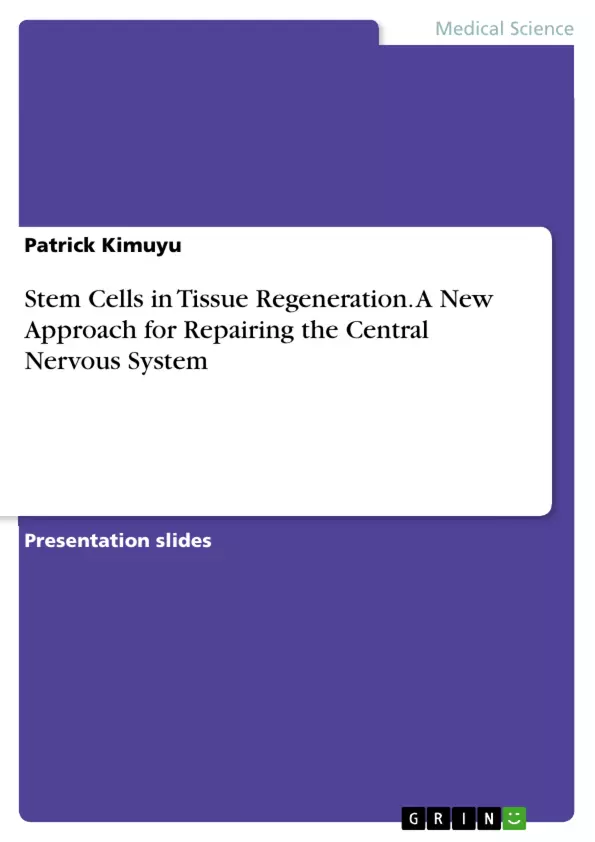Overview: In retrospect, Amyotrophic Laterals Sclerosis (ALS) and Spinal Cord Injury (SCI) are aggravating neurological circumstances that affect people all over the globe, considerably decreasing the value of existence, both for the sick persons and their families.
Objective of the presentation: This presentation aims at demonstrating the promise of stem cell-based therapies for regeneration of the central nervous system.
Technique: Appraisal of the writings from the last ten years of human research utilizing stem cell translocation as the key remedy, in the company of adjuvant remedies or not.
Summary:The present analysis provides a synopsis of the situation of the art concerning the restitution of the spinal cord and acts as a beginning position for an upcoming research.
Inhaltsverzeichnis (Table of Contents)
- 1 INTRODUCTION
- 2 Early Evidence
- 3 Spinal Cord Damages and their Impacts
- 4 STEM CELLS IN NERVOUS SYSTEM REGENERATION
Zielsetzung und Themenschwerpunkte (Objectives and Key Themes)
This presentation explores the potential of stem cell-based therapies for regenerating the central nervous system, focusing on the treatment of Amyotrophic Lateral Sclerosis (ALS) and Spinal Cord Injury (SCI). It aims to demonstrate the promising outcomes of stem cell transplantation in these neurological conditions.
- The potential of regenerative medicine in tissue repair and restoration
- The role of stem cells in regenerating damaged tissue and organs
- The impact of spinal cord injuries and ALS on individuals and society
- The use of stem cell transplantation as a therapeutic approach for spinal cord regeneration
- The effectiveness of stem cell therapy in promoting neural regeneration and axonal growth
Zusammenfassung der Kapitel (Chapter Summaries)
- 1 INTRODUCTION: This chapter introduces the concept of regenerative medicine and highlights the significant advancement in stem cell technology. It emphasizes the potential of stem cell therapies to restore tissue function and address tissue injuries or degenerative pathologies. The chapter further discusses the objective of the presentation, which is to review the methods through which stem cell therapy can advance spinal cord regeneration in humans.
- 2 Early Evidence: This chapter delves into the early research on spinal cord regeneration, including the work of Sir Charles S. Sherrington and Santiago Ramon Y Cajal. It discusses the historical understanding of the spinal cord and the neuron doctrine, highlighting the evolving view of its regenerative capabilities.
- 3 Spinal Cord Damages and their Impacts: This chapter explores the common pathologies of Spinal Cord Injury (SCI) and Amyotrophic Lateral Sclerosis (ALS), emphasizing their significant impact on individuals and society. It discusses the causes and effects of these neurological conditions, highlighting the urgent need for effective therapies.
- 4 STEM CELLS IN NERVOUS SYSTEM REGENERATION: This chapter focuses on the emerging role of stem cell transplantation in resolving spinal cord damages. It reviews the various strategies used to regenerate the central nervous system, particularly through the use of Schwann Cells (SCs). The chapter examines the research findings on SCs, emphasizing their potential in promoting axonal regeneration and remyelination after injury.
Schlüsselwörter (Keywords)
This presentation focuses on regenerative medicine, stem cell therapy, spinal cord regeneration, Amyotrophic Lateral Sclerosis (ALS), Spinal Cord Injury (SCI), Schwann cells, axonal regeneration, remyelination, and neurotrophic factors.
- Quote paper
- Patrick Kimuyu (Author), 2017, Stem Cells in Tissue Regeneration. A New Approach for Repairing the Central Nervous System, Munich, GRIN Verlag, https://www.grin.com/document/384581



